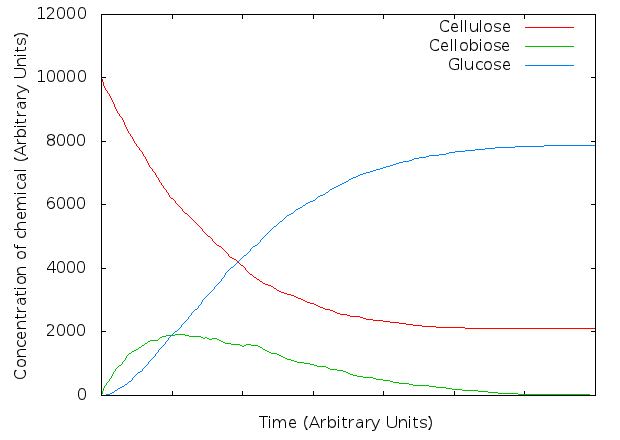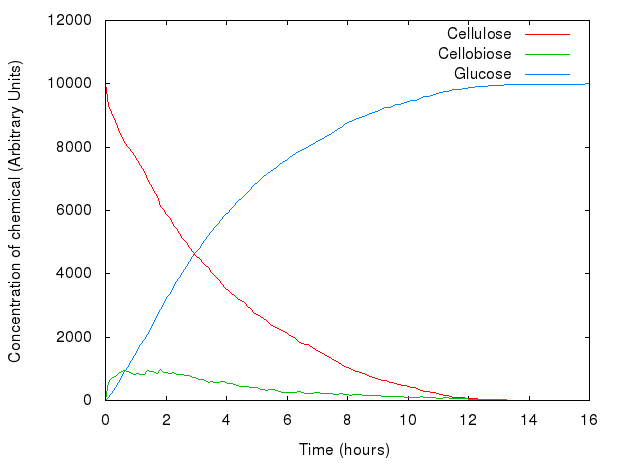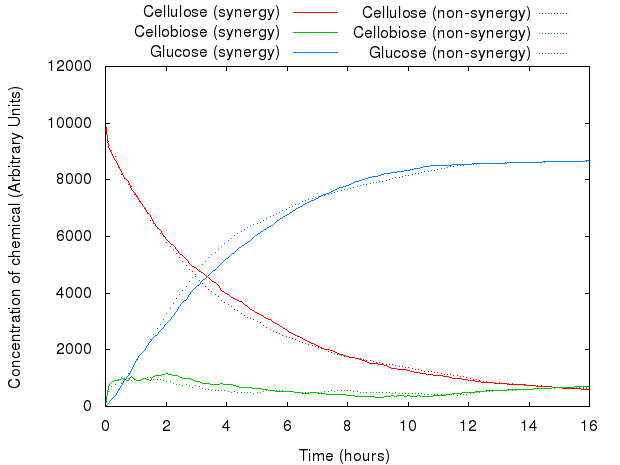Team:Edinburgh/Cellulases (Kappa model)
From 2011.igem.org
| Line 10: | Line 10: | ||
tocmain.className = 'toc tochidden'; | tocmain.className = 'toc tochidden'; | ||
}); </script> | }); </script> | ||
| - | |||
| - | |||
| - | |||
| - | |||
| - | |||
</html> | </html> | ||
<div class="main_body"> | <div class="main_body"> | ||
Revision as of 12:12, 7 September 2011
Cellulases (Kappa model)
Contents |
Kappa
Kappa is a stochastic, agent-based language for simulating interactions in (mostly) biological systems. It has been used by several iGEM teams before, most notably by Team Edinburgh 2010, who used it to develop a model awarded the Best Model Prize.
Advantages of Kappa:
- easy to learn - you can summarise the syntax of the whole language on one page
- no need for knowing mathematical formulae (ODEs) - the sophisticated code simulates the system based on rules instead
- the models are relatively easy and quick to develop, and easily scalable by connecting more models into one
- there exist some graphical tools to aid creation of models - e.g. RuleBase
Kappa represents the world in terms of agents. Agents in Kappa can have states, and can be linked to one another by bonds. Reactions are represented as creation/deletion of agents/bonds.
For example, the reaction of a bound enzyme producing two end products would look like that:
Enzyme(activeSite!1), Substrate(enyzmeBindingSite!1) ->
Enzyme(activeSite), Product1(), Product2()
Structure of the model
We thought that a neat model would represent cellulose as a long fibre of glucoses linked together:
However, manually inputting that would be a considerable effort. Instead, we made a Kappa system which would build cellulose for us, and then, using Kappa syntax, took a snapshot of the model. Two variants were created, one with long (10,000 glucoses) fibres of cellulose and another one with short (1,000 glucoses) fibres.
Then, Endoglucanase would cut Cellulose somewhere in the middle:
Also, Exoglucanase would cut Cellulose at end-points:
Fontes and Gilbert (2010) have suggested that Exoglucanase is inhibited by its end product - Cellobiose, so we modelled that interaction as well.
Finally, β-glucosidase would cut dimers (i.e. Cellobiose):
We also modelled end-product inhibition of β-glucosidase by glucose.
Non-synergistic model
We developed our first, non-synergistic model in Kappa, based on the system as seen above. A preliminary model showed similar graphs to those in Kadam, Rydholm & McMillan (2004). However, after closer examination, the model made us think of one problem - glucose trimers.
Glucose trimers
The first slightly unanticipated result of our simulations was that, depending on how the model is set up, trimers of glucose can appear. If none of the (simulated) enzymes can degrade this, it will be one of the terminal products.
The following graph shows concentrations of glucose, cellobiose, and "cellulose" (which is defined as any glucose chain of length greater than 2) in a simple simulation where all three cellulase types are present but none is capable of degrading the trimer... at the end, all of the so called "cellulose" is composed of these trimers.
This immediately led us to the question of whether any of our three enzymes (Cellulomonas fimi endoglucanase, exoglucanase, and β-glucosidase) are in fact capable of degrading the trimer...
Improved model
For the rest of our models, we assumed that some of our enzymes CAN degrade such trimers, and modelled Endoglucanase to degrade them.
Parameter fitting
We carried out a series of experiments in order to fit parameters to our model. The aim was to generate graphs similar to those in Kadam, Rydholm & McMillan (2004) (since back then we did not have any data available from the wet lab). We manipulated the kinetic rates of reactions and relative concentrations of enzymes.
After an overnight series of experiments using a computing cluster in the School of Informatics, we came up with a set of values for parameters of our model.
You can download the ready model as a .zip file:

Synergy model
Since Kappa models can be easily extended (by adding new agents, or reaction rules), we tried to make a synergistic model based on the non-synergistic model.
We introduced new agents: an E.Coli cell and several copies of INP, to be linked together as shown below:
However, that did not act as we predicted. The following graph presents both models.
The graph above shows that for the same set of parameters, there is virtually no difference between the two systems. This is because Kappa does not have the notion of proximity, i.e. the simulator has no way of distinguishing between the products of enzymes produced just a second ago and the ones floating far away in the solution:
Spatial Kappa
Spatial Kappa is an extension to Kappa made by our last year's team (Team Edinburgh 2010). It seems like the extra functionality of compartments added by Spatial Kappa would help develop a model of synergistic action.
Our model could work in the following way:
- In the synergistic system, the enzymes are all in one compartment, meaning that the end-products will be available to the enzymes. The products and substrates would be allowed to diffuse across compartments, while the enzymes would not.
- The non-synergistic system would be very similar, but the enzymes could diffuse across compartments.
PICTURE HERE
TODO: Synergy - enzymes don't move. Non-Synergy - enzymes move around.
References
- Fontes CMGA, Gilbert HJ (2010) Cellulosomes: highly efficient nanomachines designed to deconstruct plant cell wall complex carbohydrates. Annual Review of Biochemistry 79: 655-81 (doi: 10.1146/annurev-biochem-091208-085603).
- Kadam KL, Rydholm EC, McMillan JD (2004) Development and validation of a kinetic model for enzymatic saccharification of lignocellulosic biomass. Biotechnology Progress 20(3): 698–705 (doi: 10.1021/bp034316x).
 "
"








